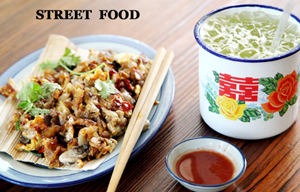Preserving the common heritage
The recently concluded World Street Food Congress threw up many questions, and while the answers are still tentative, the concern about a fading heritage is apparent across the nations. Fan Zhen reports from Singapore.
Vibrant and varied, street food is about as essential to pop culture as music or literature are in the preservation of heritage. The inaugural World Street Food Congress held in Singapore in early June is precisely about the survival of street food, and how advocates can seek ways to preserve, professionalize and identify new possibilities and opportunities to keep it alive.
The Congress was held in Singapore, where street food culture is doing famously, but still facing the common challenges that also threaten this culinary genre from New York to Portland to India, Thailand and China.
Food celebrities and advocates converged for the Congress, including television personality and ex-chef Anthony Bourdain, Noma co-owner Claus Meyer and from China, Travel Channel’s popular celebrity host Johnny Chan, and Pauline D. Loh, managing editor and food editor of China Daily.
The Congress and its auxiliary events were organized by Makansutra, the food portal and publisher founded by KF Seetoh, Singapore's street food ambassador.
Also invited to participate in the discussions were the heads of cooking schools, including Singapore polytechnics, private cooking schools and the Culinary Institute of America, which had just started a branch on the island republic.
Almost all the speakers voiced similar concerns: That increasing urbanization and globalization would erode traditional culinary heritage, especially street food.
Chan says his memory of hometown and childhood is always interwoven with the taste and fragrance of the street food he had when he was young. He worries that this heritage will soon fade as the younger generations refuse to take up their parents’ professions.
"Street food started because of survival. The reason why there are a lot of elderly hawkers is that they needed to survive. But over the years, they slogged to send their kids to school, and so their children became engineers and got their MBAs. They won't come back to become hawkers," says Chan.
Pauline Dawn Loh, managing editor at China Daily, echoes the same concern.
Loh points out that in China, street food became a victim of revolutions. First there was a turbulent period in the 60s to 80s when everyone ate at communal kitchens and anything old or traditional were looked askance as counter-revolutionary. Street food almost disappeared during this time.
The next revolution was when China opened up its economic doors in the 1980s, and in the resulting waves of efforts to keep up, vendors were chased off the streets in the name of hygiene and progress.
But the revolution Loh fears the most is the fast food revolution where pizzas, burgers and fried chicken are taking over in big cities.
"Young Chinese who work in the big cities far away from home succumb to fast food culture because they don't have the time or space to cook."
"It is the price China pays for modernization. They sometimes forget where they come from in the quest of being the fastest, the newest," KF Seetoh adds. "If you don't have your cultural heritage behind you, you will come from nowhere and go nowhere."
Compared with the grim situation in China, the street food in Portland in form of food carts is thriving due to the support from local government.
"The food cart scene has been included in the next 30-year plan, because the authority understands it brings people together and creates a community," says Brett Burmeister, managing editor and co-owner of Food Carts Portland.
Anthony Bourdain points out that individually owned food reflect a community's identity.
He believes a perfect future for street food would be "a culinary wonderland", an utopia where "rich and poor alike, whatever your income level, all of us will line up for an hour and a half for an authentic street food dish. Street food can be a great equalizer."
Singapore is often thought of as the cleanest, safest, and, some would say, most sterile country in Southeast Asia. While it's true that Singapore is graffiti-free and remarkably efficient, a vibrant street food culture pulses through the city, reflecting the island's diverse cultural makeup.
Richard Tan, division director of the Hawker Centers Division at the National Environment Agency (NEA), shares how Singapore’s government supports hawker centers that have played a role in preserving street food heritage besides providing cheap and affordable food.
"We offer employment and communal spaces for people to gather and eat," he says. "That's why we build hawker centers."
When asked what the Congress hopes to achieve through this event, James Oseland, editor-in-chief of Saveur magazine in America, summed it up.
"We are trying to draw the attention and send out the message: Hey, world, we are talking about street food now instead of some luxury high-end dining experience."
And as KF Seetoh says: "The conversation has started. Let's see where it goes."




















